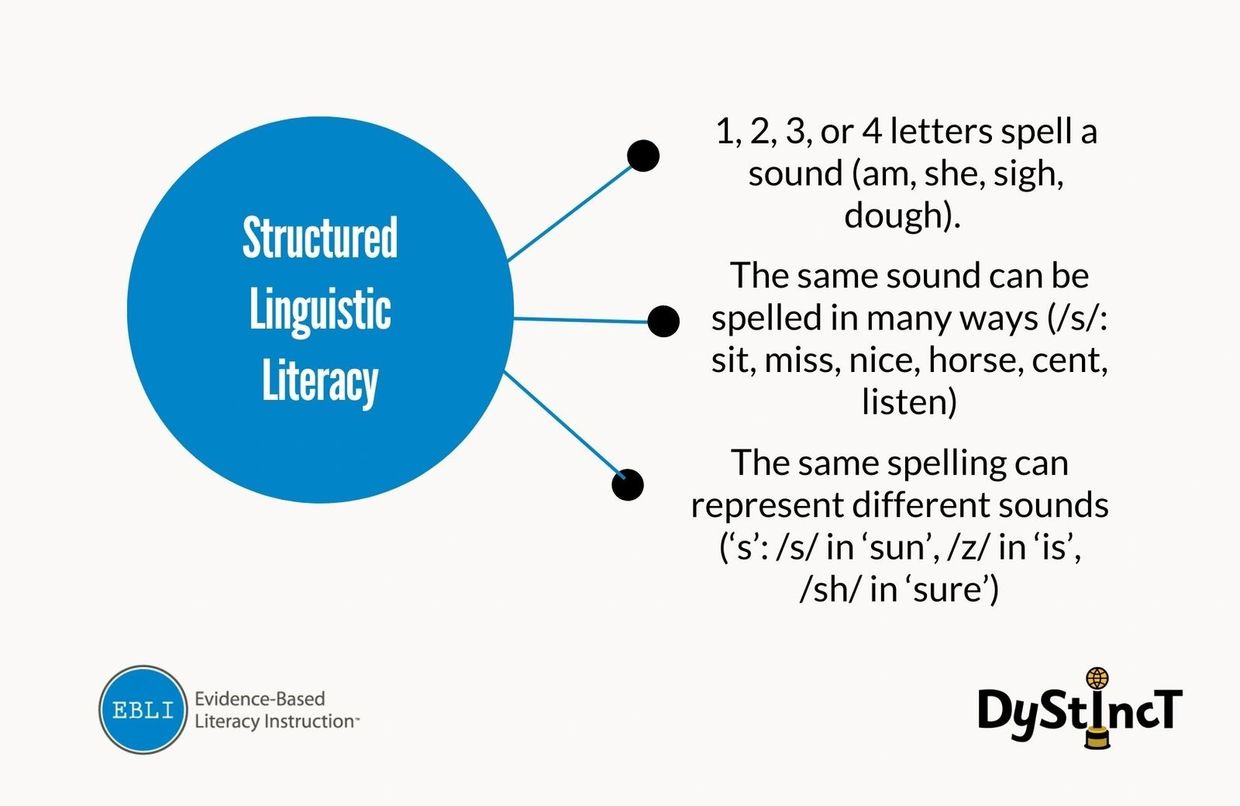
Speech to Print (S2P)
What is Speech-to-Print?
What are the benefits of S2P?
What are the benefits of S2P?

Speech-to-Print methodology, also known as Structured Linguistic Literacy (SLL) or Linguistic Phonics (LP), is a systematic and explicit approach to teaching reading and writing. Unlike traditional methods that begin with letters and their sounds, Speech to Print starts with the spoken language- the sounds from the words we speak- and then matches the spellings (graphemes) to the sounds (phonemes).
The core principle of Structured Linguistic Literacy is that spoken language is the foundation of written language as opposed to the other way around. This approach recognizes that children come to school with a well-developed ability to use spoken language and brains that naturally recognize patterns, and it leverages these strengths to teach reading and writing.
Speech-to-Print approaches provide explicit instruction in the concepts that are the foundational basis of the English alphabetic code, which circumvents the need to teach students an excessive amount of the code. Once students have a firm understanding of how the code functions, they can transition more quickly to implicit learning or self-teaching. This important distinction accelerates the acquisition of accurate, automatic reading and writing.
What are the benefits of S2P?
What are the benefits of S2P?
What are the benefits of S2P?

The Speech to Print method offers several advantages:
- Efficiency: By starting with sounds students already know, the learning process is accelerated.
- Inclusivity: This method has shown significant success with all students, including those who struggle with traditional reading instruction and students diagnosed with dyslexia.
- Reduced Cognitive Load: By focusing on patterns rather than rules, students often find the process less mentally taxing.
- Integrated Skills: The simultaneous teaching of reading, writing, and spelling reinforces learning across all areas.
- Flexibility: Students learn to approach unfamiliar words with confidence, applying their knowledge of sound-spelling relationships.
- Rapid Progress: Many students advance quickly to reading a wide range of texts.
What is the science of S2P?
What are the benefits of S2P?
What is the science of S2P?

The effectiveness of Speech-to-Print is rooted in cognitive science and research on how the brain processes language. Dr. Mark Seidenberg, a cognitive scientist and expert in the Science of Reading, has contributed significantly to our understanding of the reading process.
Seidenberg’s research emphasizes the importance of phonological awareness and the ability to map sounds to letters in learning to read. He describes a phenomenon he calls “escape velocity,” where students transition from explicit instruction to self-teaching. Speech to Print methodology aims to achieve this transition efficiently.
The process works as follows:
- Students are explicitly taught how the English alphabetic code works.
- They learn to apply these concepts to all words.
- As their skills develop, they require less support and can increasingly teach themselves new words.
This approach aligns with what cognitive scientists call the “Simple View of Reading,” which posits that reading comprehension is the product of decoding ability and language comprehension.
Excerpt from the October 21, 2024 EBLI Blog by Nora Chahbazi

EBLI and Orton-Gillingham (O-G)
Our Founder's O-G to EBLI Story by Brandy N. Gulliford
In 2017, I was trained in a program based on the Orton-Gillingham (O-G) approach. I was teaching Kindergarten at a public elementary school in Colorado at the time. It gave me a roadmap for teaching reading and spelling that I never had before. Prior to my O-G training I only had short literacy training sessions that never really seemed to make much of a difference in my students' literacy skills. Even in my Master's program for Elementary Education I wasn't really taught how to effectively teach reading, writing, and spelling.
O-G training changed that. My students showed progress in learning to read that I had not experienced previously. I taught using the O-G approach in my classroom for 5 years. During that time I took additional print-to-speech trainings, completed my practicum, and earned my Orton-Gillingham certification. I founded Altitude Tutoring in 2020 and retired from classroom teaching in 2022. In the summer after I retired, I passed my KPEERI exam and earned my certified dyslexia interventionist credential. I then began providing literacy intervention full-time to help students improve their literacy skills.
As a classroom teacher, I never had the opportunity to teach literacy to older students. It was in my role as a certified dyslexia interventionist that in some cases I would work with students who were in 5th grade and were reading at a 1st grade level. I would assess them, analyze their data, and start teaching the O-G sequence at the appropriate concept. I noticed as I was progress monitoring them that the growth was not what I was used to seeing with my younger students. It was taking so long to see measurable progress. The students were overwhelmed with the excessive rules and exceptions. The kids felt defeated and that the texts were "babyish". I had to admit that I was feeling defeated too.
Because they were so far below grade-level expectations and struggled to get the decoding and encoding mastery requirement O-G programs set to move onto the next concept in the sequence, I couldn't get to the more complex multisyllabic word instruction I knew they desperately needed to be able to read more fluently and close the gap. This slow progress led me on a search to find a more effective and efficient way to teach reading. I also wanted my students to enjoy the literacy work they were doing with me.
That is when I discovered speech-to-print (linguistic phonics) and Evidence Based Literacy Instruction (EBLI). Although it was new to me, speech-to-print as a way to teach literacy had been around since the early 1900s and is actually based on how our written code was intended to be used. On my hunt for more information, I reached out to other O-G certified practitioners who were teaching with EBLI to find out how it was working for their students and if they felt it was improving their student outcomes more quickly and... it was! I could not find a single practitioner who said it wasn't working for their students. More than that, everyone I spoke with said they wouldn't go back to teaching using the O-G approach now that they were using a speech-to-print approach.
Shortly thereafter, I started my EBLI training. At that time, I switched all of my students (grades K-6) from OG instruction to EBLI. I completed my EBLI certification several months after beginning the training and the improvement in my students' literacy growth was astounding. Not only that, they were happy. They enjoyed the work we were doing and the texts we were reading. Parents were also reporting that their children were actually excited to read at home and the work we were doing was translating to improved scores at school. Additionally, students were able to move on from literacy intervention quicker. As an interventionist, this was huge! I want to help students that need me, but then I want them to move forward so they can continue to grow without the level of support I provide.
I think my O-G to EBLI story is a testament to the fact that when we teach students in a logical way that accelerates learning, they will perform better and have higher confidence in their own abilities.
EBLI and O-G: How Are They Different?
For over a century, educators have been searching for the best way to teach children to read. This blog will explore two approaches to literacy: Orton-Gillingham (OG), a print-to-speech approach and EBLI (Evidence-Based Literacy Instruction), which is built on the Linguistic Phonics, speech-to-print framework.
Both approaches share the same noble goal: helping every student, including those who struggle the most, become skilled, confident, and joyful readers. Both are explicit, systematic, and intentional. However they differ significantly in how they get there- and those differences ripple into classroom practice, student engagement, and overall outcomes.
The most fundamental distinction between OG and EBLI is their starting point. Orton-Gillingham (Print-to-Speech) begins with letters and sounds, and further along in instruction incorporates spelling rules and syllable types to teach the complex code.
EBLI (Speech-to-Print) starts with the sounds of spoken language- the foundation every child already knows. Emerging learners are introduced to single-letter spellings within the context of whole words, making the process meaningful and relevant. They segment the sounds to build the word, blend the sounds back together, and then both say and write the word. Further instruction of more complex text includes sorts and additional activities, rooted in words and starting with the sound first, then mapping the sounds onto the spellings in print, teaching reading by teaching spelling.
This pathway is flexible, integrated, and accelerates acquisition of sound spelling correspondences; mastery is not a prerequisite to moving forward. Speech or sounds, which are natural, lead instruction.
Excerpt from the September 13, 2025 EBLI Blog by Nora Chahbazi

At Altitude, our expert practitioners use the EBLI resource. Structured Linguistic Literacy (SLL) teaches the logic of the English alphabetic code in a way that helps learners more easily apply this code to accurate, automatic reading and spelling. SLL begins instruction with a word, breaking each word into its individual sounds, providing the letter(s) that represent the sounds (spelling), and then blending those sounds back together to read the word. Reading and spelling are taught in the same activity and with the same process since these processes are reversible and utilize the same code. For emerging readers, once the simple code (1 letter representing 1 sound) is taught and applied, they move on to instruction in the more complex code.
Words containing the complex code utilize concepts that are unique and common in English:
- 1, 2, 3, or 4 letters spell a sound (am, she, sigh, dough).
- The same sound can be spelled in many ways (/s/: sit, miss, nice, horse, cent, listen).
- The same spelling can represent different sounds (‘s’: /s/ in ‘sun’, /z/ in ‘is’, /sh/ in ‘sure’).
- A strategy to decode multisyllabic words is crucial.
Many spellings for a sound can be taught at once, even to emerging learners, once they have been taught the simple code. Similarly, many sounds that go with the same spelling can also be taught. Patterns are emphasized, and application to accurate reading in text and accurate spelling in writing is part of instruction. With the Structured Linguistic Literacy approach, there is an abundance of multisyllabic word instruction, especially words with 3 syllables or more. These multisyllabic words are taught explicitly, early in instruction, and regularly for learners. This instruction with multisyllabic words facilitates vocabulary by teaching prefixes, suffixes, and root words in context. Mastery of concepts and skills is obtained over time with instruction that spirals and interleaves what has been learned by the student to help advance further learning.
Dystinct Issue 13: How and Why a Structured Linguistic Literacy Approach Closes the Gap Quickly by Nora Chahbazi
Ready to Get Started or Have Questions?
Altitude Tutoring LLC
